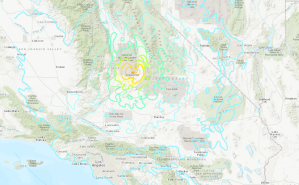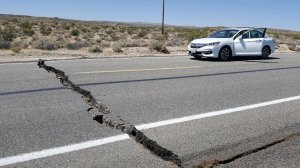A state of emergency has been declared in Ridgecrest after a magnitude 6.4 earthquake rocked the Mojave Desert and was widely felt around Southern California Thursday morning, the Fourth of July.

The quake struck at 10:33 a.m. and centered about 7 miles southwest Searles Valley, roughly 11 miles east-northeast of Ridgecrest, 109 miles north of San Bernardino and 121 miles north-northeast of Los Angeles, according to the U.S. Geological Survey.
It had a preliminary magnitude of 6.6 before being downgraded.
The “mainshock” was preceded by magnitude 4.2 temblor that shook the area approximately 30 minutes before the large quake, seismologist Lucy Jones tweeted, calling the earlier tremor a foreshock.
A short time after the magnitude 6.4 earthquake, aftershocks measuring 4.6, 4.2, 3.8 and 3.5 hit the same area, USGS reported.
Shaking Widely Felt, Damages Reported

(Credit: Karaleigh Roe via CNN)
Thursday’s shaking, which registered in the Los Angeles area as a long, rolling motion, and lasted for at least 20 seconds. It was felt by many throughout Southern California and also as far as Sacramento, Reno, Las Vegas, Phoenix and Tijuana, according to USGS’s website.
Some minor injuries were reported near the epicenter, and there appeared to be light damage.
Gov. Gavin Newsom declared a state of emergency in Ridgecrest, a desert city of about 29,000 that was among the areas hardest hit.
The Kern County Fire Department responded to nearly two dozen incidents in the aftermath of the quake, everything from structure fires to medical assistance, officials said. Search and rescue teams were dispatched to the area.
At least one home was engulfed in flames as fire crews worked to extinguish the blaze, video from the scene showed.
The Ridgecrest Regional Hospital was evacuated early in the afternoon, according to Kern County fire officials. Fifteen patients in the emergency room were taken to other hospitals in northern L.A. County, while others sheltered in place.
Several people suffered minor injuries in the quake, mostly involving broken glass and fallen shelves.
The San Bernardino County Fire Department tweeted that buildings and roads were damaged in Trona, an unincorporated community in a remote area of the county that is located about 10 miles northeast of Ridgecrest.
The road damage included a 12-inch crack across Highway 178, about two miles west of Trona Road, according to the San Bernardino County Sheriff’s Department. That was quickly filled in by Caltrans crews.
In other northwest parts of the county, some buildings were found to have minor cracks, according to the Fire Department. There were also broken water mains, downed power lines and rock slides.

The extent of the damage was not immediately known.
Six people accepted services at an American Red Cross shelter at the Kerr McGee Community Center in Ridgecrest, the organization said.
USGS data showed the quake’s epicenter was within the 1.2 million-acre Naval Air Weapons Station China Lake, where a desert test range is located. The commanding officer there said damage assessments were being conducted, though he declined to provide detail. The airfield on site should be operational by Friday, he said.
No damage was immediately reported in the Los Angeles area, though the city’s Fire Department went on earthquake mode.
The L.A. County Fire Department also reported no damage.
Jones said the temblor was large enough that it probably broke the Earth’s surface.
More Aftershocks Anticipated
Experts warned that more seismic activity is expected in the coming days.
Jones described the aftershock sequence as “robust.” Within the first 90 minutes of the temblor, there were six events of magnitude 4.0 or greater, and approximately 30 above magnitude 3.0.
“That means there will be plenty more aftershocks today,” she tweeted.
The #Ridgecrest earthquake is having a robust aftershock sequence. There have been 6 M4+ events and ~30 M3+ in the first 90 minutes. That means there will be plenty more aftershocks today.
— Dr. Lucy Jones (@DrLucyJones) July 4, 2019
By 3:15 p.m., more than 220 aftershocks had been recorded, with 12 of them at least magnitude 4, according to the Southern California Seismic Network.
Jones indicated there is a roughly 9% chance that the main temblor could trigger an earthquake of comparable or greater magnitude within the next week.
The chance of a magnitude 6.0 or higher in the area in the next several days is 20%, while the likelihood of a magnitude 5.0 is about 80%, according to USGS.
Those odds, however, will decrease by about half on Friday, according to seismologists.
At a news conference at Caltech, Jones stated there will most likely be an aftershock of at least magnitude 5.
“When the probabilities are this high, then you can say, yes, there will probably be a magnitude 5 today,” she said.
No Alert From Early Warning App
Although the earthquake measured as a magnitude 6.4, it did not trigger a warning from the city’s ShakeAlertLA app, which became available for download on Android and Apple smartphones earlier this year.
The early warning system was designed to send users information when a 5.0 or greater earthquake strikes the county prior to shaking being felt.
As the city of Los Angeles explained in a tweet, “The #ShakeAlertLA app only sends alerts if shaking is 5.0+ in LA County. Epicenter was 6.4 in Kern County, @USGS confirms LA’s shaking was below 4.5.”
Caltech’s lab did receive an early warning, predicting the impending quake would measure magnitude 6.2, Jones said.
In response to complaints, officials said it would lower the app’s threshold; it was unclear when that change would go into effect.
Largest Quake to Hit SoCal in Decades
Thursday’s earthquake was the largest to hit Southern California in nearly 20 years.
A magnitude 7.1 quake struck the Hector Mine area, nearly 50 miles east-southeast of Barstow, in October 1999, according to Jones.
And it was the second largest in the region since the catastrophic magnitude 6.7 Northridge quake devastated the region in 1994, killing dozens of people and causing billions of dollars in damages.
If Thursday’s temblor had hit in a more densely populated area, it like would have caused many more injuries and damages in the billions of dollars, the California Earthquake Authority said in a statement.
KTLA’s Melissa Pamer and Cindy Von Quednow contributed to this story.
Correction: A previous version of the story incorrectly identified the Northridge quake as the largest earthquake in Southern California in the past 25 years, and gave the incorrect magnitude for that temblor. In fact, the 1999 Hector Mine quake was larger than the Northridge quake. The post has been updated.





















